B2B Customer Journey Mapping: Examples from b2b markets
This article introduces customer journey mapping (CJM) in the context of customer experience management. It looks at what it is, why we should do it and the approaches that can be used to undertake this. It also explores the importance to any growth strategy of understanding customer interfaces with a company and its brand. The examples cited in this article focus on b2b customer journey mapping specifically.
More and more companies now actively recognize that customers are their biggest asset; with no customers to buy our products and services, there is no business at all. People who have a positive customer experience are more likely to spend more with that supplier, pay a premium for that service, and recommend the supplier based on the experience it delivers. People who change to another supplier/brand are more likely to do so because of poor service, and they are equally likely to broadcast this.
In order to achieve growth plans, a company needs to widen its scope; seeking new markets, leveraging existing markets and/or developing its product or service portfolio. The link between positive customer experiences and business success is compelling. Therefore, any company seeking to realize its growth plans ignores this link at its peril.
Mục Lục
Differentiating on Customer Experience
In an increasingly competitive business environment, the ability of a supplier to deliver positive customer experiences with the product or service, which reinforces the brand at all points, can make a significant difference. This is the basis of “experience-based differentiation”. Advertising campaigns of many leading brands today communicate the experience of a brand or product, rather than its product features. The most successful brands have delivered an outstanding customer experience over the lifetime of their customers.
Customer Experience Management is defined by Bernd Schmitt (2003) as…
“the process of strategically managing a customer’s entire experience with a product or company.”
The key elements of his definition are firstly that it is a strategic process and thus embedded in all a company does and secondly, that it is a process which travels the entire length and breadth of the customer’s journey, from start to finish. Ideally, it even extends beyond this point, as a company seeks to re-engage and win back any lost customers.
A typical approach for a Customer Experience Strategy involves a process of several stages commencing with an understanding of the customer position, and including a customer journey map.
Figure 1: Customer Experience Strategy
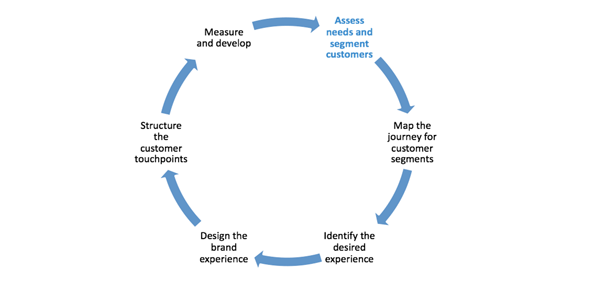
Customer Experience Strategy
This gives the opportunity to examine the experience and identify what the desired experience is. The loop is closed by structuring the experience to ensure it happens and then putting controls in place to ensure the desired effect has been achieved.
What is the Customer Journey Map?
In order to design great customer experiences, it is critical to understand the current customer experience; creating a Customer Journey Map (CJM) is an ideal framework for this. The CJM is described by Schmitt as…
“documents that visually illustrate customers’ processes, needs, and perceptions throughout their relationships with a company”
It is a visual representation of customer interactions with a company and thus a tool to investigate, analyse and ultimately lay the foundations to improve customer experiences. B2B customer journey analysis requires us to step into the shoes of the customer and understand how our processes impact on the experience he or she has with the brand and the company.
The CJM is a blueprint for the journey taken by the customer, marking all touchpoints. It should extend from touchpoints designed to raise awareness and interest – including advertising and marketing efforts, PR, etc. – through to the touchpoints associated with usage e.g. sales reps, accounts teams, support services complaints handling, etc. It should also extend to the cessation of the relationship with the company e.g. closing a bank account, switching to an alternative provider, etc. as the handling of this stage can be critical in turning around experiences and inviting future return to usage.
A Customer Journey Map should therefore include:
- A flowchart or diagrammatical representation of the journey which customers take
- All interactions and interfaces (touchpoints) between the customer and the company/brand
- Likely “pain points” in the journey i.e. areas where the customer is likely to experience difficulties or negative emotions
- Key “moments of truth” i.e. areas where there is the opportunity to “make” or “break” the relationship.
Once maps have been developed, it is also common to then populate them further, to include:
- Identification of departments, regions and people responsible for the delivery of the customer experience at each touchpoint (e.g. customer service, technical support, HR, sales and marketing, etc.)
- Linkages between touchpoints
- Emotions elicited and desired in the customer at each touchpoint
- Importance ratings for each touchpoint. This can include looking at the internal perception of importance compared to customer measures
- Performance of the company/brand at each touchpoint. As with importance, the gap between the internal and external perception can be identified.
Further Reading
The Customer Journey and How Businesses Buy:
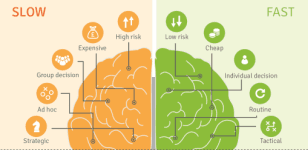
Types of Customer Journey Maps:
B2b customer Journey Maps can take several forms, depending on the needs of the business and the extent to which business processes are incorporated into the map.
The typical b2b customer journey map:
A map that provides a strategic overview of the stages of the b2b customer journey, along with the component b2b touchpoints where a customer can interact or engage with the company at each stage of the journey.
Figure 2: A typical business-to-business map
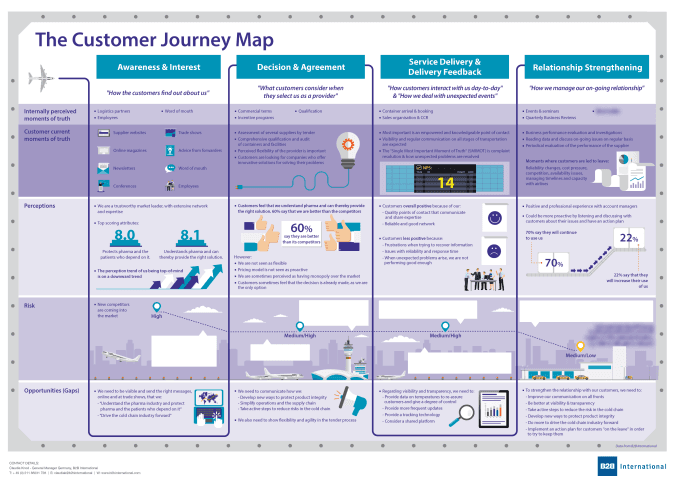
A typical business-to-business map
The tactical b2b customer journey map:
The tactical b2b customer journey map focuses on a particular touchpoint (or cluster of b2b touchpoints) to highlight the journey that the customer goes on at that stage. This is particularly useful when looking at an important (or painful) touchpoint where performance needs to be at a high standard. Tactical maps can also be a useful tool for training teams that are responsible for a particular stage of the customer journey.
Figure 3: A tactical map
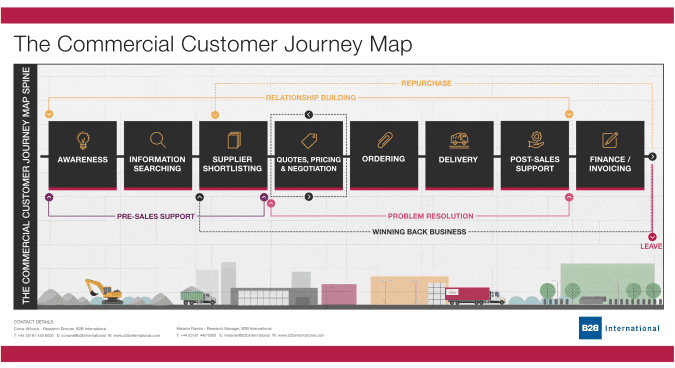
A tactical map
The performance and improvement customer journey map:
The performance map is similar to the tactical journey map, though it goes into more detail around the performance at each step of a process, and provides key recommendations at each stage. These are invaluable when identifying “pain points” and “bottlenecks” for the customer, and identifying how processes impact on customers. Therefore, they can be very useful for circulating information to those responsible for making the improvements on a day-to-day basis.
Figure 4: A performance and improvement map
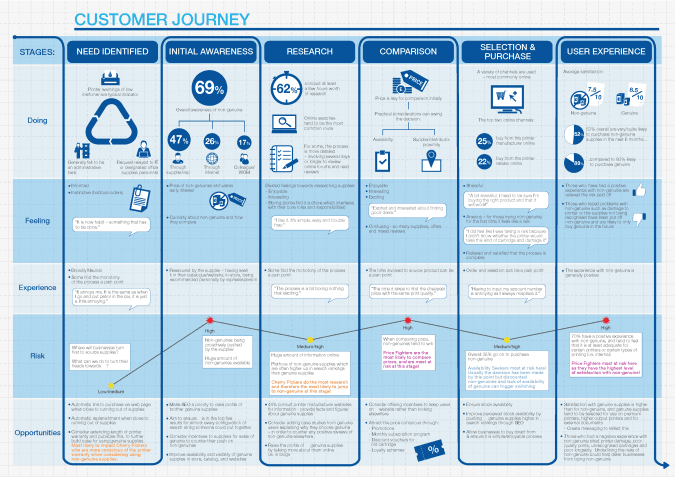
A performance and improvement map
Why Conduct Customer Journey Analysis?
Most large corporations operate in ways which separate different functions of the service delivered to its customers e.g. ordering, technical support, complaint handling, warranty claims, general inquiries, etc. This is generally felt to be necessary to build expertise and manage operations. However, unless the various functions are joined up, the customer can feel this disconnect or even fall between departments or functions. By tracking and describing the customer’s experience at each stage of this ‘journey’, a company is able to…
- Deliver seamless, streamlined products and services that cut across departments within the company
- Tailor services to meet the needs of both customers and the business
- Understand the experiences, thoughts and feelings of customers
- Develop compelling propositions.
Creating a customer journey map has obvious advantages within a company, not least in developing a customer culture and the internal buy-in with the brand. Customer journey analysis exercises focus the business on the customer. Simply by spending the time considering what the customer’s lifetime experience is with the company highlights the strategic positioning the customer has within the company, the customer culture, and the degree to which the customer is considered in service design and delivery.
Many brand strategies are developed in the absence of the customer and yet it is the customer who lives the brand. Their perception of the brand comes not only from the messaging, imagery and promotions, but also from the experience they have with the company and its products. Whilst this philosophy can now be seen in the imagery of the mass promotional campaigns of some leading brands, it has to be backed up by the experience delivered when interacting with the supplier. A company that understands the customer journey in detail is able to design “ideal” experiences and orientate the operations and the people delivering these to engage its customers with the brand and build loyalty.
Problems and Pitfalls
Customer journey touchpoint analysis is not without its problems. Knowledge and perceptions, both internal and external, are required to develop the Customer Journey Map, particularly in more complex B2B markets. Pitfalls which can be experienced when embarking on the process can include:
- Getting buy-in from senior management
- Getting co-operation from staff who are responsible for the various elements of the customer journey
- Availability of resources to undertake the process
- “Blank sheet syndrome” – having difficulty getting started.
Further Reading
5 Tips to Ensure Success in B2B Customer Journey Mapping:

How do you do it?
Depending on the industry in which a company operates, the range of its operations and the type of products and services it offers, the starting point will be to define the different groups of customers and to establish how different their “journey” with the company can be. Typical approaches here are to segment b2b customers on firmographics (i.e. classifications which make them different such as geography, age, SIC code), behaviors (i.e. what they buy) or needs (what they are looking for). This exercise is required before any journey mapping can take place.
The next step is to map the journey of each of the customer segments from end to end, detailing all the customer touchpoints with the company, and the customer responses to these. This can be done using a variety of methods which engage stakeholders involved in the process, and ensures their input into the development of the maps. A combination of workshops, staff interviews or focus groups, and customer interviews are normally indicated. These are then validated externally with customers (current, potential and lost) to ensure the maps encapsulate the customer experience, and no critical touchpoints are missing.
Through internal workshops (usually senior management):
- To establish a high-level view of the customer journey
- To establish buy-in at senior level
- To start thinking about things from the customer’s point of view
Through internal interviews (usually departmental):
- To validate the high-level map
- To ascertain more touchpoints at particular stages
- To understand pain points and important touchpoints
Through customer (both current and lost) input – interviews, focus groups and social media:
- To validate the journey both in terms of stages and touchpoints
- To understand important touchpoints for customers
- To understand pain points for customers
- To understand gaps in internal vs. external perception
Further Reading
Read our collection of interviews with CX professionals talking about their journey to CX excellence:
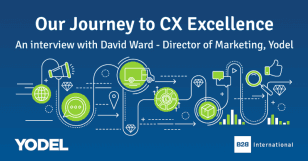
The Value of Customer Journey Mapping & Challenges in B2B Markets
Customer journey mapping is just one stage in the move towards a customer centric approach. It marks the starting point; placing the experience of the customer at the heart of what the company does and how it operates. It provides a single overview of how customers interact with the business, focusing the company’s thinking on the customer and how the service appears from an external perspective. It is all too easy for large corporations to think in terms of departmental tasks, and journey mapping facilitates cross-departmental working to understand the impact on the journey for the customer, and consider the “desired” emotional response from the customer at each point.
However, customer experiences, rather than being neat and linear, are often convoluted and complex, particularly in B2B markets where tendering, multi-site requirements, and technical product and service requirements often define journeys. These complexities can confound the b2b journey mapping team, resulting in maps which are either overly complex or overly simplified, failing to capture the most important b2b touchpoints from the customer perspective and the emotional response to these from the customer. Resultant actions can then be process- rather than experience-driven.
The outputs from b2b customer journey mapping deliver a tool for identifying outstanding and problematic areas, as well as “delight” and “choke points” in the journey. Using the CEM process cycle (see below), the next stages are to design the “ideal” experience, put in place the processes and people addressed to deliver it, and develop a feedback mechanism to measure progress. As a result, valuable resources can be targeted where they will have the greatest impact for the customer coupled with efficiency for the business.
Closing Thoughts
As a key element of Customer Experience Management, customer journey mapping is a “step back” exercise, and one which affords the opportunity to design truly innovative experiences which differentiate. However, it has real value in engaging staff at all levels within a business with its customers and their experience of the company and brand.
Customers are the greatest advocates of a brand or specific product or service: they tell stories and they make recommendations. They have the power to infect others with their enthusiasm for adoption, and therefore have to be seen as a core element of long-term strategic growth.















![Toni Kroos là ai? [ sự thật về tiểu sử đầy đủ Toni Kroos ]](https://evbn.org/wp-content/uploads/New-Project-6635-1671934592.jpg)


